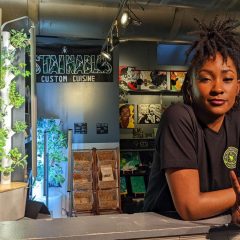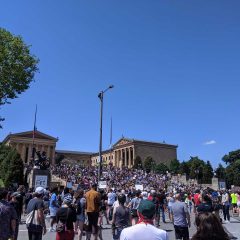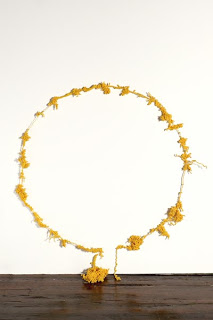
I first saw Bruce Campbell’s work in a group exhibition at the late, lamented Falling Cow Gallery (S. 4th St., Philadelphia) last year. He showed two pieces in which I detected a debt to Eva Hesse: The Golden Moment of Realization and A Million Little Pieces. Both were made of the most modest materials (yarn and paper straws) yet occupied significant visual and psychic space. I decided to follow up with a studio visit and found the artist in a large loft near the Berks stop on the blue subway line. He was working on a group of drawings, mostly large scale in black chalk with sweeping arm gestures, although others were surprisingly detailed and controlled. Another series was done in sumi ink with a brush, and carried the wonderful title: Plans for an Increasingly Impossible Sculpture I – V. Which brings up the fact that while he does a fair amount of very strong work in two dimensions, Campbell was trained as a sculptor (M.FA., Massachusetts College of Art).
His first degree was in ceramics from the Kansas City Art Institute, and he credits seeing an exhibition of Tom Friedman’s work with the realization that he no longer had to work in clay. When I asked Campbell about the influence of Hesse he surprised me – he didn’t know her work. But when he mentioned studying with Jim Hodges I suspected that he got to Hesse at second hand. He often uses lines to create three-dimensional work and some works morph into others; others are constructed from bits of material that were left over from the creation of earlier pieces. Besides yarn and straws he has used wood, steel, aluminum, cast paper, earth (in outdoor performances)and breath on glass. The idea comes first then Campbell finds the suitable materials (although he acknowledged that some materials suggest their own ideas).
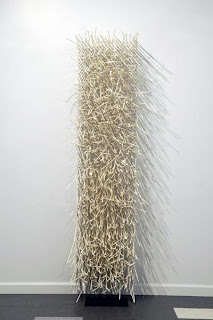
Bruce Campbell A Million Little Pieces (2007), 71 x 17 x 16″, paper straws; photo courtesy the artist.
It is the presence of these generating ideas behind work of significant sensual beauty that first attracted me. Campbell showed me a group of earlier drawings that at first looked like delicate collages: done on fine fabric, they were actually realistic renderings of various sheets of newspaper (in different languages), but with areas left blank as if the paper had been cut out. He used a Russian newspaper for a piece that made reference to Malevich, with a white void instead of a black square.
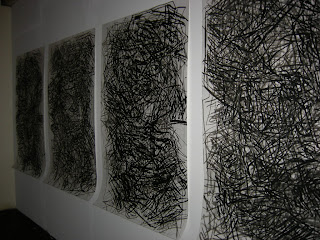
Bruce Campbell, detail drawings in progress (2008), photo courtesy Andrea Kirsh.
Campbell moved to Philadelphia a couple years ago because of friends and it seems like a good place for his next step. He’s already had a residence (at Ant Farm in Marquette, Nebraska), does occasional critical writing for Big Red and Shiny, a blog out of Boston, and has exhibited in a couple of group exhibitions here and nationally, and solo shows in Texas and Massachusetts but his first solo exhibition in Philadelphia will be at Rebecca Templeton Gallery in November. I’m looking forward to it.



